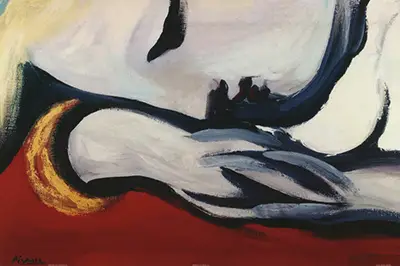It was painted in a more Surrealist and Post-Impressionist style than his more famous Cubist paintings, both in the use of colour and form. In The Rest, Picasso depicts a woman sleeping peacefully on her arms. The painting contains zones of colour with deep curved outlines.
In one hand, there is a casual extension of her hand, making the limb placement highly personal as a lover's view. The woman in this painting is Marie-Thérèse Walter, one of Picasso's first mistresses. She is the subject of many of Picasso's works including slight variations of this one, also called Le Repos.
Elsewhere, Marie features through Picasso's famous Vollard Suite etchings in a neoclassical style. Another particularly famous Picasso work which depicts Marie-Thérèse is the erotically charged and much lauded The Dream.
In The Dream Marie-Thérèse's head contains a hidden phallus in addition to several other hidden phalluses in the portrait, underscoring the psychoanalytical root to Picasso's 1930s work.
Marie-Thérèse Walter served both as mistress and model for Picasso from 1927 to 1935, and as mother to his daughter Maya Widmaier-Picasso. They began their relationship when she was seventeen years old and Picasso forty-five, then living with his first wife Olga Khokhlova.
Some of Picasso's most famous works were depictions of Marie. The two met at the Galeries Lafayette in Paris, 1925. They began their relationship without Olga's knowledge, living close to one another until 1930 when she moved into a house opposite Picasso.
Upon becoming pregnant with Picasso's child, Olga was made aware of Marie and Picasso's secret relationship and, upon hearing the news, Olga left Picasso with their son Paulo.
Although the two never divorced, Olga lived separately to Picasso until her death in 1955. From 1935, Picasso fell in love with a new mistress, the French photographer Dora Maar, leaving Marie for her after she became jealous. The two mistresses were highly juxtaposing influences for Picasso's work.
Where Marie provided Picasso with bright, blonde and colourful inspiration—as in The Rest—Dora was a brooding and dark influence. Marie and Maya were financially supported by Picasso throughout their life. Following Picasso's death in 1973, Marie committed suicide in 1977.
The period in which Picasso painted The Rest is commonly referred to by his new influences, namely when Surrealism and neoclassical styles featured in his work.
The colour and form of The Rest is therefore predictably dreamy, bold and bright. It is intimate and fluid in its use of colour and line, creating a sense of tranquility in sleep.
As the art critic Athur Dento has argued, "Picasso invented a new style each time he fell in love with a new woman".
In The Rest, Picasso confirms this placement of Marie in his work, as she occupies a unique place in Picasso's oeuvre; neither Cubist nor entirely Surreal, but informed by both approaches as a transitionary period.
As such, The Rest is reflective of Picasso's more romantic and sensual 1930s style, visualising the impact Marie had on Picasso's style through both a lustful energy of colour, here red, and his freer, personal style through new brushwork in the depiction of bodily curves.
Pablo Picasso was the son of a painter and arts teacher. Encouraged to pursue painting by his father, Picasso took his advice and training before moving to Madrid to study at the Real Academia de Bellas Artes de San Fernando.
Although Picasso soon dropped out, he flourished in Madrid studying paintings at the Museo del Prado. Picasso experienced scattered success until his move to Paris where he became known for his influential and groundbreaking Cubist style which he co-founded with the French painter Georges Braque.
In Paris, Picasso established himself as a groundbreaking artist, popularising several new methods and mediums of art such as collage and constructed sculpture. His lasting legacy, however, remains the Cubist painting method; a style depicting highly geometric and minimalist application of line, colour, tone and perspective.

